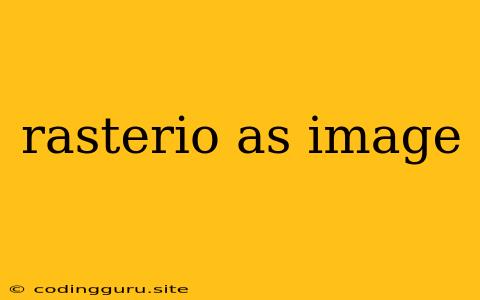Rasterio: Your Gateway to Image Processing in Python
Rasterio is a Python library that allows you to read, write, and manipulate raster datasets like images. It's a powerful tool for geospatial data scientists, remote sensing experts, and anyone who needs to work with image data in Python. But how exactly does it work? Let's dive into the world of Rasterio and explore its capabilities.
Why Rasterio?
Rasterio shines because it offers a convenient and consistent way to interact with raster data formats. It's built on top of the GDAL library, a widely used open-source geospatial library, giving it access to a wide range of supported formats, including:
- GeoTIFF
- PNG
- JPEG
- ECW
- MrSID
Rasterio also seamlessly integrates with other popular Python libraries like NumPy and SciPy, allowing you to easily perform advanced analysis and manipulations on your raster data.
Getting Started with Rasterio
Let's start by installing Rasterio. You can install it using pip:
pip install rasterio
Once installed, you can import it into your Python script:
import rasterio
Now you're ready to explore the world of raster image processing with Rasterio.
Reading and Writing Raster Images
Reading an image with Rasterio is as simple as using the rasterio.open() function:
with rasterio.open('my_image.tif') as dataset:
# Access metadata, data, and other properties of the image
print(dataset.bounds) # Get the image bounds
print(dataset.crs) # Get the coordinate reference system
image_data = dataset.read() # Read the image data as a NumPy array
Writing an image is just as straightforward:
with rasterio.open('new_image.tif', 'w', **dataset.meta) as dst:
dst.write(image_data)
This snippet creates a new GeoTIFF file called 'new_image.tif' using the metadata from the original image and writes the processed image data to it.
Manipulating Raster Images
Rasterio provides various tools for manipulating raster images. Some common operations include:
- Cropping: You can crop an image to a specific area using the
dataset.read(window=...)function. - Resampling: Resampling allows you to change the resolution of an image. Use
dataset.read(out_shape=..., resampling=...)for this. - Projection: You can reproject an image to a different coordinate reference system using
dataset.read(out_shape=..., out_transform=...). - Band Selection: Extract specific bands from a multi-band image using the
dataset.read(indexes=...)function. - Mosaicking: Combine multiple images into a single mosaic using
rasterio.merge.merge()function.
Rasterio also provides functions for performing advanced operations like:
- Georeferencing: Correct the geometric distortions of an image using control points.
- Orthorectification: Correct for geometric distortions caused by terrain and camera position.
- Image Enhancement: Apply filters and transformations to improve image quality.
Working with Metadata
Rasterio allows you to easily access and manipulate metadata associated with raster images.
Here are some common metadata properties you can retrieve:
- Dataset Profile:
dataset.profileprovides a dictionary containing important image metadata like the image size, resolution, coordinate reference system, and data type. - Bounds:
dataset.boundsprovides a tuple representing the geographic extent of the image. - Coordinate Reference System (CRS):
dataset.crsprovides information about the projection used by the image. - Transform:
dataset.transformprovides a matrix that maps pixel coordinates to geographic coordinates.
A Real-World Example: Calculating NDVI
Let's put Rasterio to use by calculating the Normalized Difference Vegetation Index (NDVI) from a multi-band image:
import rasterio
with rasterio.open('my_image.tif') as dataset:
red_band = dataset.read(1)
nir_band = dataset.read(2)
# Calculate NDVI
ndvi = (nir_band - red_band) / (nir_band + red_band)
# Create a new GeoTIFF file for the NDVI image
with rasterio.open('ndvi_image.tif', 'w', **dataset.meta) as dst:
dst.write(ndvi, 1)
In this example, we read the red and near-infrared (NIR) bands from the image, calculate the NDVI using the formula, and then write the NDVI values to a new GeoTIFF file.
Conclusion
Rasterio is an invaluable tool for anyone working with raster image data in Python. Its ease of use, wide format support, and integration with other libraries make it a powerful and versatile solution for a range of tasks, from simple image processing to complex geospatial analysis. As you explore its capabilities further, you'll discover how Rasterio can unlock a world of possibilities within the realm of image analysis.
